January 4 - 10, 2015: Issue 196
Adriaan van der Wallen
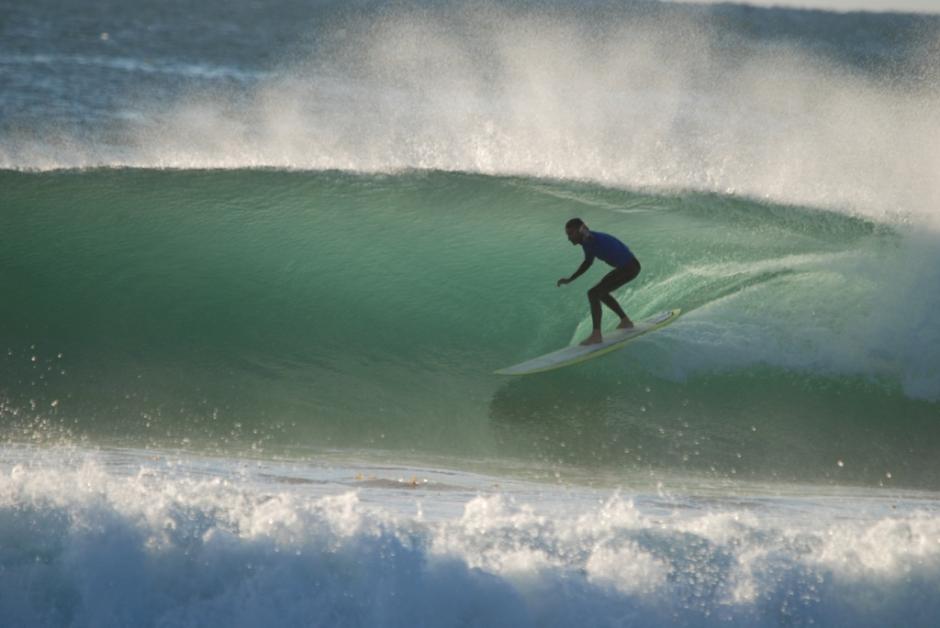
Palmy Longboarders - classic Adriaan Van Der Wallen.
Adriaan van der Wallen
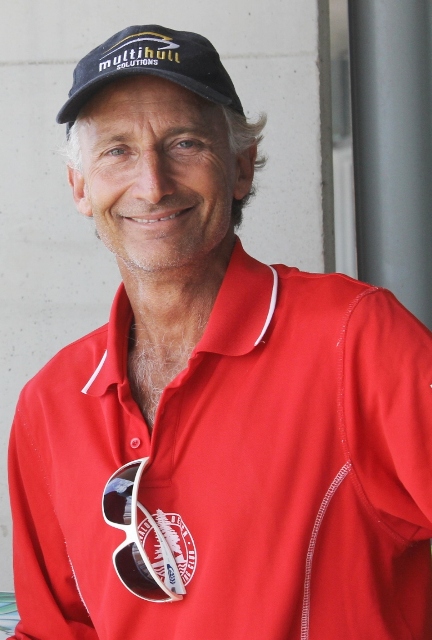 A definitive saltwater man, with a love of Pittwater in his blood, Adriaan can regale you with fish stories that will make you head straight to where the freshest fish can be procured for a fish feast. Succinct and articulate, the great outdoors, a love of family, a love of children mark his every day. Born and bred in Pittwater you can see him heading down to Careel Bay Wharf or over to the mangroves as a child, fishing, rowing, swimming, and how this coalesced into becoming a Physical Education teacher.
A definitive saltwater man, with a love of Pittwater in his blood, Adriaan can regale you with fish stories that will make you head straight to where the freshest fish can be procured for a fish feast. Succinct and articulate, the great outdoors, a love of family, a love of children mark his every day. Born and bred in Pittwater you can see him heading down to Careel Bay Wharf or over to the mangroves as a child, fishing, rowing, swimming, and how this coalesced into becoming a Physical Education teacher.
Although Adriaan will tell you there are plenty who can outlap him, our records of Palm Beach SLSC show he was R.S. Beale Memorial Cup (board paddle) champion, as well as White Horse Cup winner (overall point score) and President's Cup winner at this old club 1983-84, and and continued such feats 1984-85, '85-86, featuring among Championships winners up until 1992-93.
A passionate surfer, Masters Champion, this gentleman is happiest when wet.
He is also a saver of lives who last year (2014) had the training and guts to save the lives of at least nine people swept out of their depth by one of those freak waves that will always happen. None could swim.
Even now when he relates this experience now you can sense lifelong water instincts took over and that perhaps there was a reason he lucked a place on that beach at that moment among big holiday crowds.
Where and when were you born?
In Mona Vale Hospital, 1st of June, 1966.
Where did you grow up?
I grew up in George Street, Avalon, went to Palm Beach Kindy and then did Kindy and First Class at Avalon before going to The Scots College.
What was it like growing up in Avalon during the 1970’s?
It was beautiful. I spent a lot of my time in the swamp at Careel Bay with my friends. We built cubby houses with bits of wood and stuff left on the site. I used to fish a lot off Careel Bay Wharf - we would fish from the beginning until the end of Summer.
The moment it was light enough I’d head down to Careel Bay Wharf and fish and when it got dark we’d come home – that was a pretty normal thing to do.
We caught yellowtails, bream, flathead, whiting, John Dory occasionally, we’d jag those as they came past – they were all good sized fish.
The fishermen would pull up in their boats late in the afternoon and so we’d sometimes get an extra fish. It was good, a beautiful place.
We had a little boat and would row around, it was pretty free.
Were you a Nipper?
I was a Nipper at Avalon, but I’m not sure how long for. I didn’t like getting sandy and I liked to be in the water. I know, as I’m and Age Manager, you spend a lot of time on the sand in the younger groups. In the older groups you go into the water but when I was younger I wasn’t too keen; I just wanted to go into the water.
Once you finished at Scots you went to Uni?
Yes, I went to work in the bank when I left school, National Australia Bank, and was transferred into the city to the Head Office. I liked it, it was good work, but it was office work and I preferred to be outside – I lasted about a year, doing an Accounting Degree, and then went back to Uni and became a P.E. teacher.
What was that like?
Brilliant. I wasn’t really sure what to do with my life and was on the sand at Palm Beach, teaching some kids how to surf and swim, and this was the mid 80’s, before any Surf Schools were running. A guy spotted me and said ‘you’d really like our university’.
He took me in and showed me the uni, the Australian College of Physical Education,. He worked there, I think he was the Deputy Principal at that time, and he simply said ‘ I think you’d love this and could do this for the rest of your life. You’re good at it’.
So that’s how it started.
My first teaching position was at Cleveland Street High School, a very old school in Sydney, one of the first to open. Cleveland street High and Fort Street were among the first schools here.
I worked at Redfern for seven years before transferring to Cromer Campus, which is where I am now.
NATIONAL EDUCATION. The sixth annual examination of the children attending the National schools in Sydney and the suburbs was commenced on Tuesday last, with the Cleveland Paddock school.- This school was opened about seven months ago, and is now attended by about 130 boys and 140 girls. At the examination there were 108 boys and 112 girls-total, 220. The Paddington school was examined on Wednesday, when the attendance was as follows:-boys, 62 ; girls, 67 ; infants, 43, total, 172. This school, like that on the Cleveland Paddock, was also established in the present year but notwithstanding the many inconveniences which were occasioned by the works necessary to the completion of the buildings, the examination has been, upon the whole, satisfactory. The examination of the William-street school, which was opened in the year 1851, was commenced on Thursday, and terminated yesterday, and was considered to be satisfactory. The number mustered was-boys, 227 ; girls, 147; and infants, 223-total, 607. The examination of the Fort-street school will commence on Monday next. In all the examinations that have taken place, the girls departments have not given so much satisfaction as those of the boys and infants ; and this is attributed to the fact that many changes in the female teachers have taken place, from illness and other causes ; in consequence of which the progress of the girls has been to some extent retarded. NATIONAL EDUCATION. (1856, December 20). Empire(Sydney, NSW : 1850 - 1875), p. 5. Retrieved from http://nla.gov.au/nla.news-article64981634
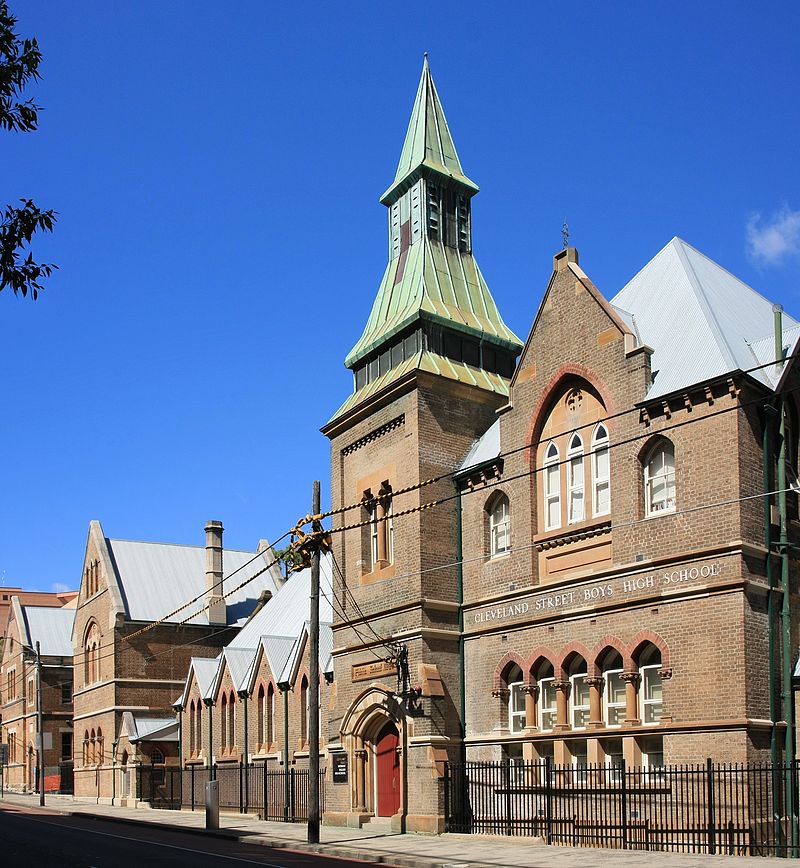
Cleveland Street High School by Adam.J.W.C., 2001.
There seems to be more female teachers than male teachers today...
There are a lot of female teachers today – when I first started it wasn’t so lopsided, there was a fairly even split. Also the age was fairly even with teachers from their early 60’s through to younger teachers. Now there seems to be a lot more female teachers than males.
What is good for the students about having a mix of male and female teachers – have you had any insights or feedback from the kids or your fellow teachers?
I know they respond differently to male and female teachers. From my experience I think it comes down to the teacher and their personality, attributes and what they can do more than them being male or female.
You do find that particular kids do work better with males, and can give the females a bit of a hard time – I’m not sure if that’s a generalisation though. Some of the boys I teach I think are brilliant and then I hear they give grief to the female teachers.
All schools are different, teachers are different and male and female ratios I know nothing about. As for kids they all respond differently and change as they get older. I like them and most like me so that's lucky for me.
What is involved in being a Physical Education teacher?
My classes are 12 to 18’s and even a few kids who are 19 that come from overseas. It’s a multicultural school. We teach Health, Personal Development, Physical Education – it’s a whole mix covering varying aspects of life and is also about informing them how to live a balanced life.
It’s the same with the physical activity involved – that too is about how to have that balance as well.
So it’s not just doing laps of the oval anymore?
No. there’s a lot of skill sessions and how to hone skills in a big variety of sports. There is Sport Elective, which is pretty good. This is called PASS, which is Physical Activity and Sports Study – students can choose to do this in Year 9 and 10.
Some of those who opt to do this may have a sporting interest or just like sport in general.
We go into fairly fine detail as part of this – biomechanics and the functions of the body – so it is a little bit more science orientated.
You would have to keep yourself up to date with what happens in this field?
Yes. Things change; nutritional changes would be a good example – and this is also about keeping your ear to the ground and learning about new programs. Our program syllabus changes too, and that involves re-doing units of work. Other changes occur too – as an example, cancer for instance once belonged in one area but then may now be classed among Lifestyle Diseases and would come in with Sun Safety and alcohol and cigarettes and diet and all the different aspects of that, the health issues that these cause are called Lifestyle Diseases – diabetes would be in there as well.
The syllabus changes and the content has to be adjusted to be put into these new areas and delivered differently.
You’re a waterman – is there anything you don’t do in and on the water – you surf, paddle, swim…
When at school I did springboard diving. When at uni I jumped in the water polo teams and we competed at Canberra, which was a lot of fun., this was called the Summer Games – for the universities.
Triathlon too – I did a lot of swimming when I was younger as part of squads, and then went on to teach swimming. I met up with Spot Anderson, who is one of Australia’s best athletes, a tri-athlete who would still be racing somewhere. He got me and some other guys at uni, into biathlon and all sorts of things and I travelled the East Coast with those guys. I never saw this as a ‘have to win’ and found it to be great fun; it was just get out there and race and go as hard as you can and have a bit of a laugh as you go along.
I did a fair bit of triathlon and Iron Man – the closest I got was to watch the guys win.
You’d be up in that front pack sometimes but during that last kilometre or so they leave you for dead. These guys are professional and if you haven’t trained like they do they leave you for dead – I was amateur and was doing it for fun and the mateship and social aspects. This would be over winter time – during summer I would do the Iron Man with the clubbies. Again that was social and fun, and you were competing against some of the best in the world. We just took it for granted because we grew up with them; Guy Leech, Craig Riddington were the ones to beat – you didn’t beat them, they were always out in front, they were the professional guys. Their skis were covered in, initially, Nutri Grain I think was the first one that came out. Straight away you would know who the professionals were on the line because they’d have all these stickers all over their craft. Then the Uncle Toby’s series started up and there was a split – the Mercers stayed with Nutri Grain and we raced against the Mercers, they did Board Rescue.
Peter Spence and I, he was a much better swimmer then me, but I was a good board paddler, would team up and do Board Rescue and race against those guys.
When you put the two Mercer boys together, or Guy Leech and Craig Riddington and we would race against them as amateurs and sometimes we would beat them, which was a lot of fun, a good feeling.
Since then I've been a 20 Beaches paddler, Cococabana to Kincumber ski paddler and the Hawkesbury Classic (111 klms) – training was taking a hand line catching fish with a lure – mostly along palm Beach – the ski makes no noise so you can paddle right into the schools of fish – great dinners after that.
The Masters Carnivals – the Adrian Curlewis Twilight Masters which you have been in since the first one – what is good about having Masters Carnivals?
I remember when I was 24 I though this is great, as you’re still young to compete in the Opens, but there was then a thing called the Restricted Surf Race, which is 24 and over at the Open Carnivals. That was my first insight into Masters and another race that you could do.
Then I got to my late 20’s and it was getting a bit more difficult to race against the young guys, and again the professional guys were way ahead – you’re working so you don’t have as much time to train as they do in the water.
Then I hit 30 and someone said ‘the Masters are on – you’d like to do this’. I went with a few of the older guys in the surf club, thinking it would be easy, this will be a cruise – and it wasn’t.
All the same faces were racing against me, all the Uncle Tobys and Nutri Grain guys – they did it as a warm up. It was just as tough, just as competitive and has never let off. As you get older the same people continue. You also get people return, they’ve had kids, they’ve grown up a bit and they’re back in the water.
The Division that I’m in now we had Heats, Semi-Finals and Finals in just about every event at the States. There were three or four races per event. If you do ten events then it’s a long tough day. If the boys are up for the relays then it’s even longer.
You’re also a Nippers Age Manager – why do you do that?
I moved from Palm Beach SLSC, where I’m still a member, to Avalon Beach SLSC because I train with the guys from Avalon and Newport. I was there for a while and then we had our kids – Petronella came along and when she was 5 I thought it was the normal thing to do in Australia, to put your kids through Nippers.
One day the boys said there’s a meeting, which I thought was all the parents coming down – they talked about who was doing Age Manager that season and said ‘welcome to the team Adriaan’ – I was like ‘what?!’ – ‘you’re ok to do this aren’t you?’ – they had a bit of a laugh and that was it, I was helped to volunteer, but I love it; I’m a teacher and for me it’s also another day on the beach.
It is a fair amount of work, I was surprised how much – and I think we had 60 five year olds on the first year for the two of us – it was hectic. We had a great time with them, lots of laughs. This year is my third year, with the under 8’s now.
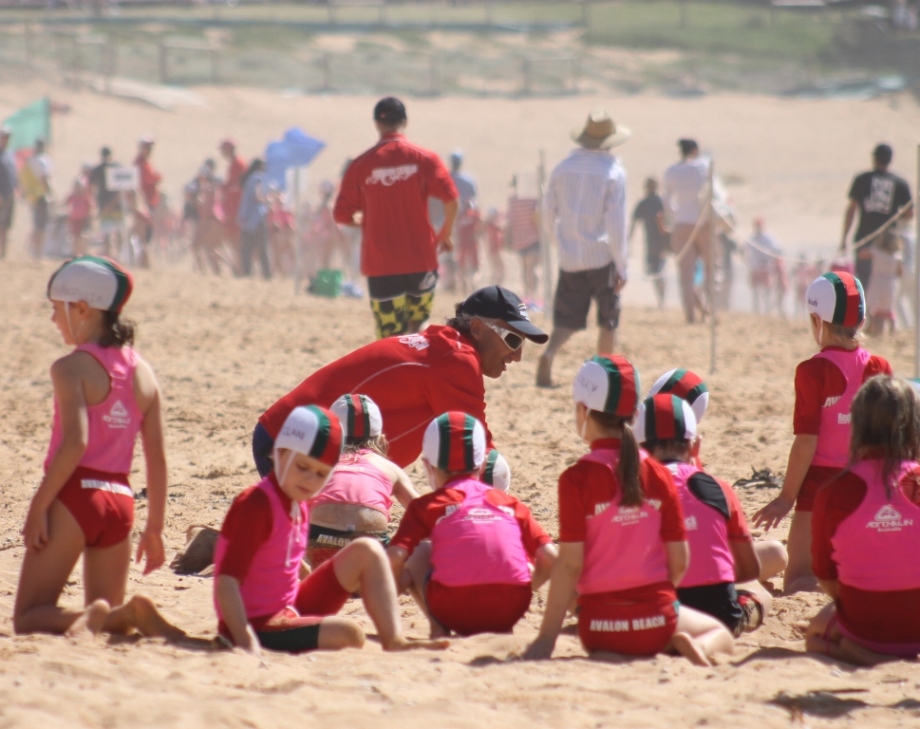
What’s is the best thing for the kids about being part of Nippers programs?
You have a book on ideas of what to do and a schedule on how to run what you’re running – but I also throw in extra pieces, little challenges. When they’re younger they don’t know they’re being taught skills for life, they’re having fun with their mates. This would be the best thing, they don’t realise they’re learning, they’re having fun.
My daughter probably wouldn’t go out in the surf at first, not by herself. Because all her friends are paddling out on these boards – we do little paddles in the shories and the pool – she just goes with the group. Before I would have to try and coax her in. when you have 40 or 50 kids all running around a rope on the shore edge, getting bowled over and getting back up laughing and continuing on, they just love it – they’re running about, just loving it, not realising they’re going through water familiarisation.
If my daughter was by herself and was knocked over by a wave she may get upset and be scared of the water – whereas when its all of them together, in a safe place, safe environment, they have a great time together.
The hour and a half just flashes by. We sometimes go a bit longer clocking up two hours – we have parents coming up asking ‘is it ok if we leave’; ‘yeah sure’; ‘are you finishing soon?’…. ‘oh, it’s a nice day, everyone is having fun..’ and we go a bit longer.
The rescue at Forster earlier in 2014 – you and Kirsty and the kids were coming home and stopped for a dip?
My daughter had lost a tooth – we were at Boomerang heading back to Palmy as there was a longboard comp at midday I wanted to go in, but Petronella wanted to buy this doll that she’d seen in the shops – so I thought ‘why not’.
We drove into Forster, Easter Saturday, so it’s packed as can be, got her the little plastic doll that she wanted and Kirsty said ‘it’s hot, let’s go for a swim before we drive home’.
There’s this little beach inside the river, inside the breakwall. I had all my boards, fishing gear, everything on the roof, everything in the car and didn’t want to leave the car in the back of the car park – I said if we didn’t get a park right at the front we’re just driving home. And if course, we got front row parking on the beach, we literally got out of the car and walked on to the sand.
We’d been there half an hour and I was keen to get the surfboard off, as I always am. The easiest one to get off was the little Nipper board as that was on the side, took that off and didn’t really go out on it – the kids were building sandcastles and whatnot – and so it was just resting next to me. Very soon after I did this….
There was massive surf on the ocean beach, it would have been well over 12 foot, tow in material, it was huge. I’d had a week of surfing and had had enough of the big waves and was happy to just have a swim.
There were these two waves – one surged up into the corner. The second one was fairly close behind it, like a double – it pushed really high up onto the beach and up against the rocks – it then went across sideways. A family of about 15 people all up were waist deep in the water. That water just hit them, just perfectly lined them up, and took them probably no more than ten metres. They washed out, off the sandbank, into a deep section of the beach and they all went under.
I’m looking at them thinking ‘what are you guys doing; just swim, it’s not far’.
They were just thrashing in the water, going under.
I was stunned, thinking ‘what’s going on?’ and then just realised ‘oh my God, they’re drowning’.
There were kids there, and dads and mums, all in one big group. They were very close together, which was lucky. I grabbed that little Nipper board and landed myself into the middle of them. I know in all rescues you do things that are wrong – I teach lifesaving and have just done this with my Year 8’s at South Curl Curl with the Cromer kids, and part of this is to teach them to always push their flotation device in to somebody and let them grab it, otherwise they’ll grab you. Maybe, in this case, I sized up the situation and realised I could get right into the middle of them, which I did – my mates reckon I would have done that as I was running; worked out whether it was safe or not to get into the middle of them.
I landed amongst the kids and some dads – I think there were four children, young little children, and three dads, although I’m only guessing that they were parents. The whole group looked very much like a family to me.
They were going under – I nudged a guy that was under the water with my foot, lifted him up – that is really clear in my head. I was up to my neck in the water, I couldn’t stand – I was grabbing people and pulling them over to the board.
Then I felt someone under my feet and I remember lifting him up by the hair and pulling him onto the board, which had handles all along the side.
There are parts which I’ve completely forgotten, totally blank – I think I just went into remote control – I think I was just grabbing their shirts, their hair, the water was murky, that brown river water, and it had been raining a lot – they’d go under the water and be completely gone – when they popped up I was grabbing them.
I remember everything was really quiet suddenly and I remember hearing two women screaming – they were about five metres away, they were going under and would surface and scream. That kind of scream you can’t describe unless you hear it, it cuts you in half, blood curdling, really bad.
I remember swimming over to them as fast as I could and don’t remember how I got them back but I’m pretty sure I got them back at the same time, and swam them back, but I don’t remember how I did that, whether I held them by the arms or by the front. I do remember when I got them to the board and that’s why I’m sure I got them both at the same time.
I got them to the board and they tried to climb onto the board and they knocked everyone else off in doing so. They were panicking, hysterical, and of course couldn’t grab onto the board because they just kept flipping it over and then I had them all, in the water again.
I remember yelling, (I’m a teacher, I keep it real simple) ‘grab the strap’ or ‘hold the strap’ or grabbing their hands and putting them on the strap and say ‘hold!’ – there was no time to explain, just short simple commands – I remember that very clearly.
They would flip the board over, and of course there are no handles on the bottom, and I remember the kids sliding off and going under – I remember thinking ‘they’re just going to drown – everyone is going to drown’.
Adriaan paused here, clearly still very upset when relating these horrible moments of the panic that sets in when people are drowning – how often are we thinking of the toll such experiences have on rescuers? How do those who love the water, and sharing it with those who are visitors, convey that it is imperative that you learn to swim – that you swim between the flags or in a patrolled area - that you must look at conditions you go to, wherever they are - and what surrounds these conditions, that thinking you are safe is ignoring the daily instances of fluke and freak waves that account for so many deaths by drowning.
Sorry … I rolled the board back over, I remember seeing the blue and grabbing their hands and really probably being very forceful then in my commands, and really loud, but at that stage I knew if I didn’t do something very seriously they were going to go, or someone was going to go.
From that stage, where I secured them all, that whole group, to touching the sand – I can’t remember what happened and what I did at all; it’s completely blank. I thought I was at the front of the board pulling it, but my wife says I was at the back of the board pushing with at least nine at that stage, there could have been more on the board, but I recall those parts I’ve spoken of, and that’s where I get nine from – there could have been two more that came onto the board while I was swimming out to the women.
I remember at one stage, as I’m bringing them in, I saw three women, also screaming, who were about five metres away – but at that stage I could not get them, I could not leave the board alone with all the people it had on it because I knew if I went and got them from there then I’d lose these ones – I tried to get this lot back to the beach first and then would figure out what to do for them – I know no one drowned that day.
I remember a guy walking out waist deep into the water – he was a really tall guy, I remember thinking ‘wow he’s big’ and ‘mate go, go, go get them’ – maybe he walked out, or swam – who knows.
I remember hitting the sand – the most amazing feeling comes over you knowing that you’ve got them, like ‘phew – got them in’
I recall two of the guys were pretty limp when they came out of the water, most of them came up onto the sand and the rest of the family were on the beach helping them.
So, they didn’t have any water skills?
None. Some of them appeared to be keeping afloat but in looking back I think they were going under, pushing off the bottom, and coming back up – that’s why I would see them splashing around on the surface for a while and then going back under. It all happened very quickly and what I did was very quick.
Based on that experience, what would you say to people going near the water; learn how to swim? Only go on patrolled beaches…?
This beach is inside the river and apparently is notorious for this, so it’s not the first time it has happened – it’s a fair way inside the river 200-300 metres. We went there because it was perfect for our kids; dead calm, flat, and easy drop off, it has a net in front of it so no sharks – but that day there was a good surge coming from the beach and it just got them. It’s not a surf beach – it’s a beach where I would go with my family, drop Kirsty and the kids at the beach there and go surf on the other side, at the breakwall where the waves are.
The mix of people there was some mums with real little kids, and I understand them not running out to help, the others at the beach were, for want of a better word, real tourists, or from the country. I saw people with the Akubra hat, white collared shirts, trousers and leather shoes. Straight away when you’re a surfer and see people with suit trousers and leather shoes on, on the beach, you think ‘they’re from out of town, not general beach goers’, and I think it’s wonderful that people come down to the coast – that beach was the most safe by far on that particular day, but the surf, at Boomerang I would have called that 15 foot – it was huge, out of control tow-in material. Definitely for experienced surfers only. The river was the perfect option.
After speaking on the phone with someone form up there after this I was told there have been other issues there, they’re aware of it. Right now Lifesaving Australia are going up and down all the beaches and grading them and seeing whether they need to be patrolled.
How long have you been in Surf Lifesaving?
Since 1983, 31 years at Palm Beach and close to 10 years at Avalon Beach.
My brother was in Palm Beach SLSC – it was 5th form, Year 11 now, and we always went to Palm Beach when we were little, so mum walked me into the clubhouse and signed the paper.
The first time I spent the night down there, you could sleep down there, I thought ‘this is amazing’- as a teenager it was just incredible; you wake up in the morning and you’re at the beach in a beautiful club. It’s still beautiful, it hasn’t changed and people still do the same each Summer.
What’s the best thing about being in Surf Lifesaving for you?
Initially it was something special and different – I’d never done anything like that before and when you’re growing up, as a Grom, you always look up to the lifesavers. You see these guys patrolling and see them as superstars or as seriously special people. So to be a lifesaver is something you could be pretty proud about.
When you start becoming part of a club it’s like a family and becomes part of your life. You don’t think of it as ‘oh, I’ve got to go down and do a patrol’, it’s more like ‘ok, we’re going down there again’.
I was Patrol Captain when quite young and that made me feel not just part of the club but also part of the place, that it was my place – it becomes part of your life. I’m down there a lot, I surf a lot, Avalon and Palm Beach mostly.
Are you a Palm Beach Longboarders member?
Yes. I was one of the founding members.
How was this club formed?
We surfed at Avalon that first time – I came back from America in the early 90’s and brought two modern Mals (Malibu’s) back with me, and these had just kicked up again. A good mate of mine, Johnny Gill and Adrian Van Druten and other guys, all locals, decide to put this club together. They said ‘are you interested?’; ‘of course I am’.
12 of us turned up at Avalon and surfed the first round, it was called ‘Hole in the Wall’, and then somewhere along the line someone decided to move it to Palm Beach – NASA (North Avalon Surf Association) was already there, I was in NASA as well then, and it just made it easier – there was already a once a month comp at Av., so to do two clubs at the same beach would be too much. So we moved to Palmy 20 something years ago.
Which is your favourite surf break?
Avalon, by far. If I go for a longboard wave it’s North Av. If there’s anything rideable on a short board I’ll go South Av.. In the last year I’ve probably surfed a lot more at Little Avalon, on the reef – I’ve taken my mal out there, surfed the longboard out there when it gets big. It’s a challenge,. Something fun to do.
I surf with a fish, a little 5’6 twin fin, I’ll surf that everywhere.
I also wouldn’t say I have a favourite spot – it’s just how I feel but most of the time, especially the last few years, I would go straight to South Avalon –it’s more about where the waves are and what’s best of the day.
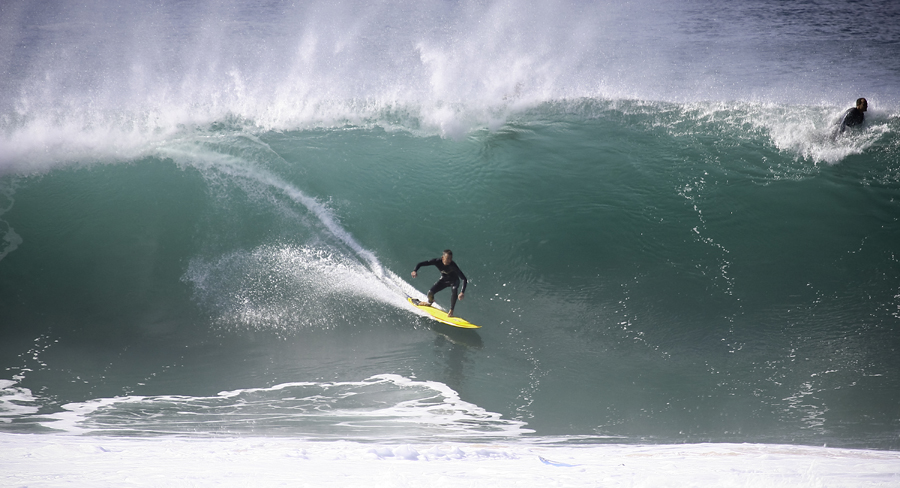
Adriaan out at Av. - Padilla Photography picture
What is your favourite place in Pittwater and why?
Pittwater is my favourite place in Pittwater.
I’ll start with when I was little – Palm Beach Kindergarten was right behind Sandy Point, of which I have good memories – my children go there now and we do exactly the same routine that my parents did. We pick them up from Kindy and go straight down that laneway to the beach and swim.
My parents lived in George street in Avalon, and I’m not sure if we walked to Paradise Beach but I definitely have fond memories of Paradise, beautiful little beach, secluded, fishing and swimming off Paradise was part of what we did.
At 3 or 4 I climbed out of my bedroom window, escaped, and walked down to Careel Bay wharf. When she noticed I was missing she may have panicked of course but knew if I was going to go somewhere the only place I’d go would be the wharf – and sure enough there I was with a whole bunch of other guys fishing.
That didn’t change for most of my youth; so Careel Bay wharf was the place to go fishing. As I got better at it, catching my bait there, yellowtail, I’d go and fish off the beach for big fish.
So I grew up at Paradise when little, swimming and fishing, at Sandy Point, kiddies corner at Palm Beach, which is where I learnt to surf – then you progress along the beach until you get to the sheds, there was a group of us that surfed the sheds, I think they call it the Pavilion but we always called it ‘the sheds’, and then when we got into our early teens we moved to Avalon. When you were able to surf you went there, went out with the big guys at Av.
For Pittwater I had a little Manly Junior, 8 foot, and my mate Mark Storr, Stally we used to call him, and I would row that, an oar each, all through Pittwater and fish all day.
We’d pull up to Careel Bay Wharf and Teddy Allan, a legend, would pull up some mornings at Careel Bay Wharf, and we’d always keep a look out for his boat, which we knew by heart. He’d say ‘do you boys want to come fishing?’ – of course! We’d chuck all our fishing gear and bikes and scooters against the shed and jump on – never ringing your parents letting them know where you are, nothing like that in those days, and we’d spend the whole day with him.
He’d take us over to Mackerel and we’d net Mackerel Beach, we’d sort all the fish for him, do that stuff that you do; clean up the fish, skin the leatherjackets – he had a whole pile of kids and we’d love it, absolutely love it – great memories with Teddy Allen.
We didn’t jump on any of the other fishing trawlers but would certainly jump on with Teddy. He’d give us a fish to take home, he probably had a good laugh about but which we thought was the best thing in the world, this great big fish.
We would have fish for breakfast and a lot of kids don’t do that now, or if you said to them we’re having fish for breakfast they’d be ‘yuk!’.
We grew up with fish for breakfast; we’d come home from the wharf with big yellowtail or if we were lucky, a bream or leatherjacket – that was pretty normal to catch bream or leatherjacket, the occasional flathead. That was a normal thing, fish for breakfast.
We’d go to Caloundra over the holidays and again, at first light we’d buy a handful of prawns and fish until they were gone, about an hour’s worth, and we’d have breakfast and probably lunch and dinner. There were a lot of beautiful whiting when we went up the coast – not so much whiting at Careel Bay, they’d be on the sand flats more.
Fish for breakfast was a beautiful thing.
We camped at The Basin when we got older – there’s just too many places to mention – that was the life and they were just absolutely magical times. Building cubby houses in the swamp, catching crabs and cooking them.
How did you meet Kirsty?
I met her at Palm Beach Golf Club as our waitress. It's where we'd eat dinner on a Friday night with the boys. I'd done that for 6 years. My brother came back from the US and wanted a Chinese meal so insisted we went there, on Saturday. That was the beginning of our relationship now in our 25th year. We may never have met. It was a good night. She started to work Fridays from then on. Lucky me.
You and Kirsty have three young children of your own now – what do you want to stay the same for them here?
We just had a picnic dinner at Clareville last night, and have done that quite a few times. We’ll get fish and chips at Palmy fish shop and walk across to the beach and have fish and chips on the sand – they go to kiddies corner with us and swim there – Petronella is in Nippers in Avalon and Saskia will be there soon – sadly the days of when I was 5 years old and would just walk to my mate Craig ‘Buzzy’ French’s house may be gone – at 5 or 6 we’d be linking up and walking into the swamp with homemade spears and running around all day in the swamp.
We’d be barefoot and running through the mangroves chasing fish at low tide as they get trapped, little bream and silver biddies were the main ones. Black fish occasionally – I’m not sure if there’s a lot of fish still in the swamp now.
Seeing little pelicans grow up there, the ibis, all the birds in the swamp – we would hunt through there to find feathers.
What is your motto for life or a favourite phrase you try to live by?
Love to live, live to love.
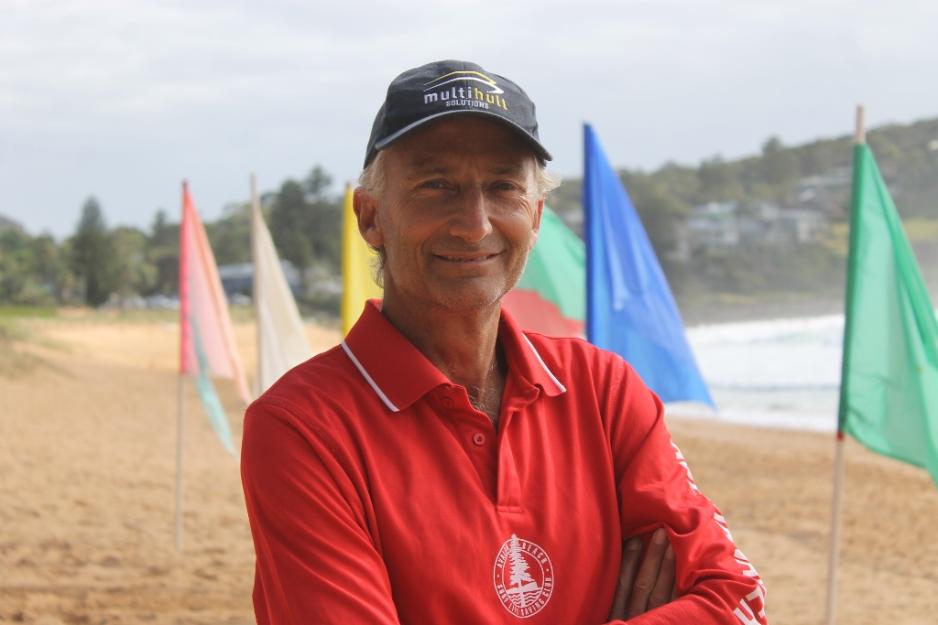
Nippers Age Manager - at Avalon Beach SLSC.
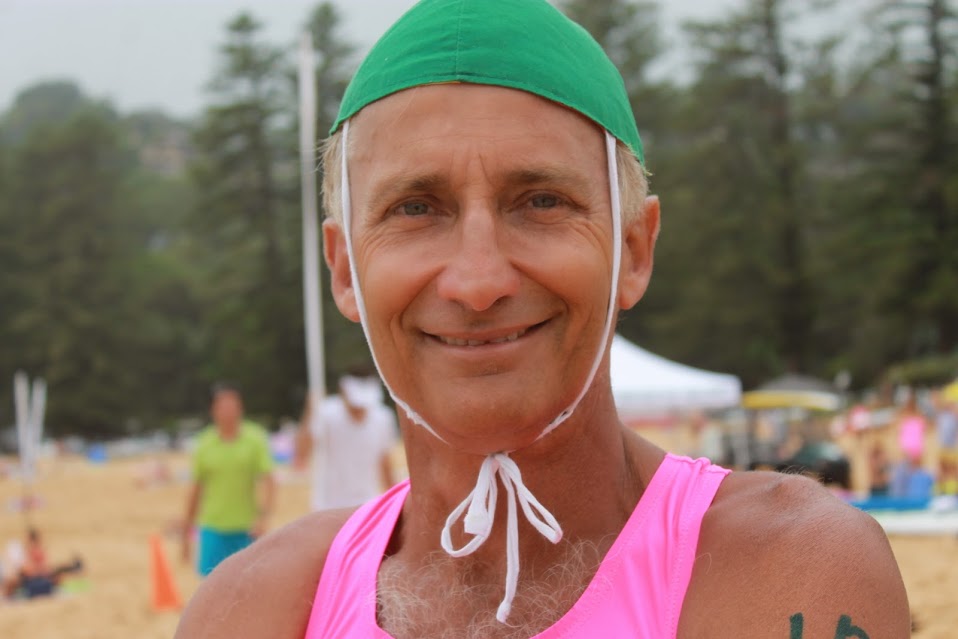
Above: Masters Champion - Palm Beach SLSC - Below: In Action at 2015 Adrian Curlewis Twlight Masters Carnival
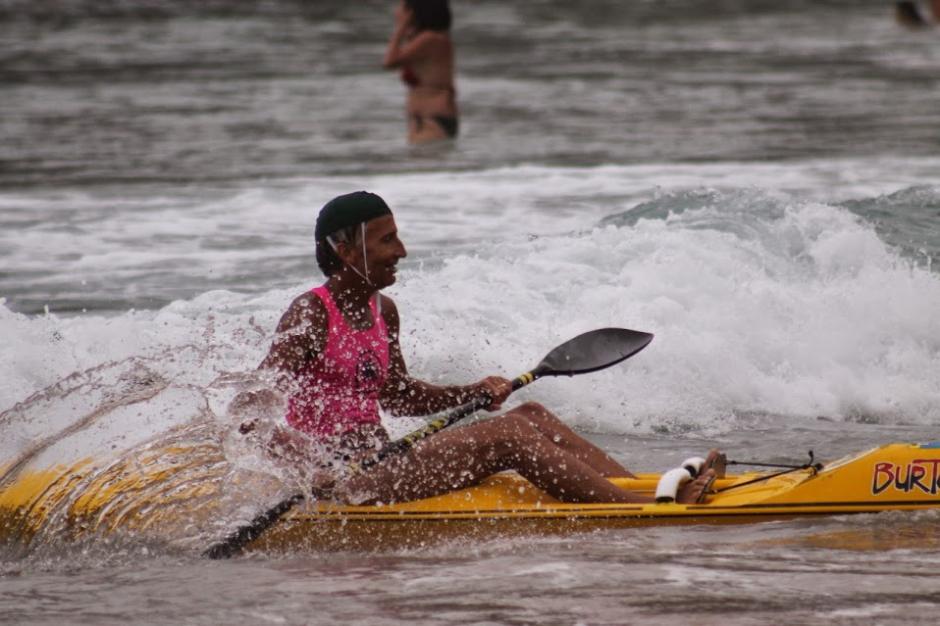
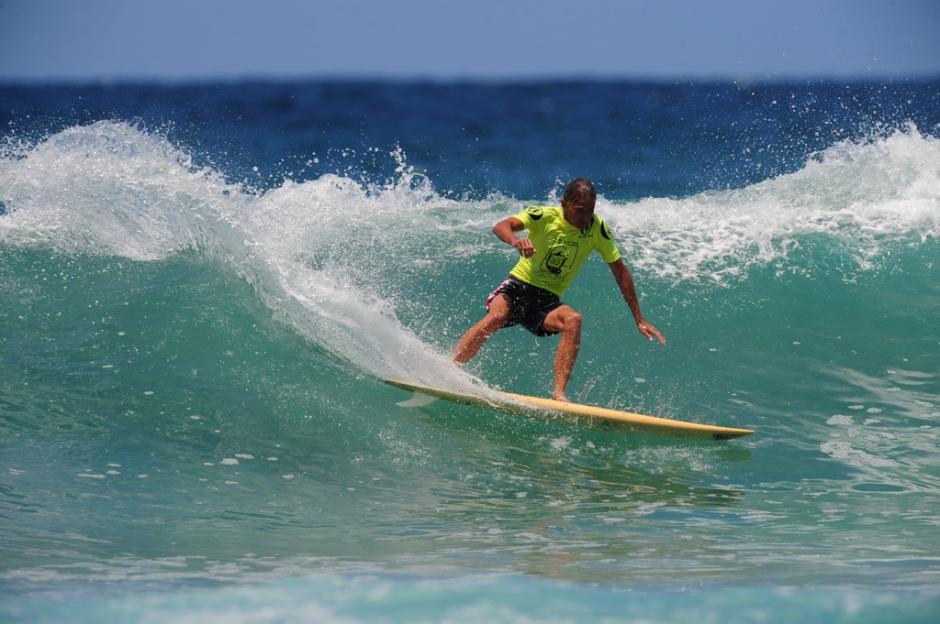
NASA Nth. Avalon Retro - GFY 156
Adriaan Van Der Wallen - Medals so far ( to December 2014)
Palm Beach SLSC
1983 - 84: President's Cup (marathons), White Horse Cup (overall pointscore), R.S. Beale Memorial Cup (board paddle)
1984 - 85: N.R Conroy Surf Race Championship, White Horse Cup(overall pointscore), Curlewis Cup, Marathon Board Paddle
1985 - 86: President's Cup (marathons), Curlewis Cup, Marathon Board Paddle, D. B. Hunter
1986 - 87: Curlewis Cup, Marathon Board Paddle
1988 - 89: R.S. Beale Memorial Cup (board paddle), Blue Harris Iron Man
1989 - 90: Blue Harris Iron Man
1990 - 91: R.S. Beale Memorial Cup (board paddle)
1992 - 93: R.S. Beale Memorial Cup (board paddle)
1993 - 94: Marathon Board Paddle
Masters Surf Carnivals
34 medals at The East Coast Masters
11 Golds at the Freshwater Carnival
Sydney Northern Beaches Branch Championships
Bronze 32
Silver 49
Gold 57
NSW State Championships ( including 4 Open Gold Individual Championships back to back)
Bronze 13
Silver 16
Gold 13
Australian National Championships
Bronze 4
Silver 6
Gold 3
World Masters
Bronze 2
Silver 1
(The above medals include both Open and Masters events and also NSW Endurance Championships)
Also Surfed in SLSC Warriors on Water Qld v's NSW in the Surf Tag, a great event surfing with fellow competitors and of course friends.
Was awarded Australian Titles Masters Champion Male Surfer in SLSC 2010 for placing 2nd in the Open Longboard and winning both Shortboard and Longboard in the Masters.
Has won titles in the Palm Beach Longboarders (Club champion x 5 seasons and won the Old Mal division x 4) and also NASA (North Avalon Surfriders Association) Masters.
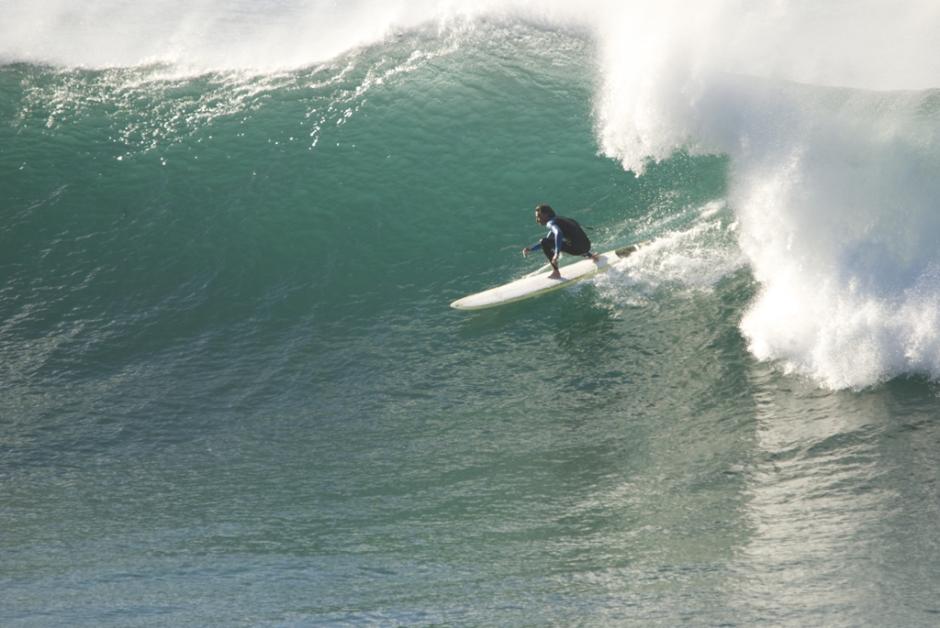
Adriaan at South Avalon
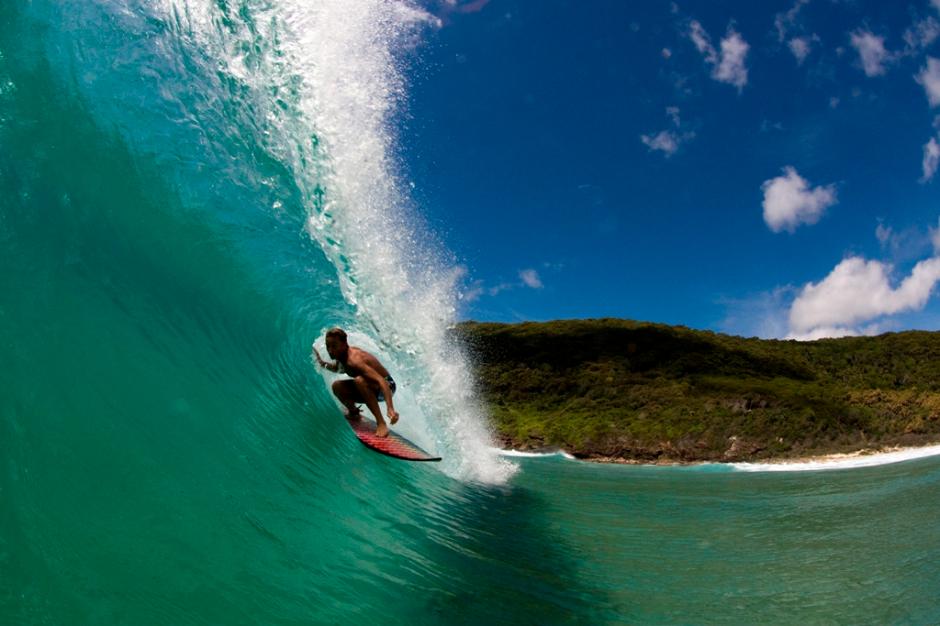
Red Bull Comp at Manly: Used my 1970's single fin 6'6", win, and flew away in a helicopter.
Copyright Adriaan Van Der Wallen, 2015.